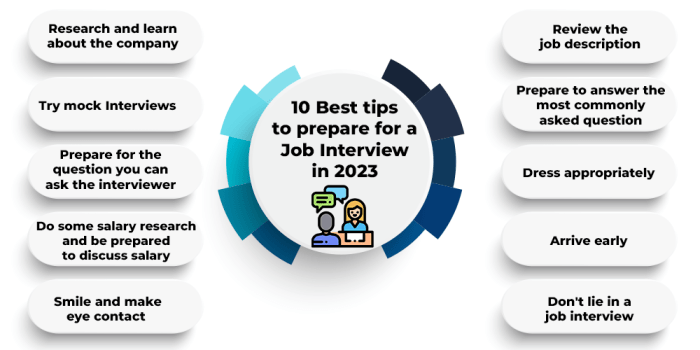Job Interview Preparation kicks off the journey to nailing that dream job! From researching the company to mastering body language, this guide has got you covered with all the must-know tips and tricks.
Get ready to rock those interviews and leave a lasting impression on your potential employers!
Researching the Company

Before heading into a job interview, it’s essential to research the company you’re applying to. This shows your interest and preparedness, giving you an edge over other candidates.
Where to Find Information about the Company
- Company Website: Start by exploring the company’s official website to learn about their mission, values, products/services, and recent news.
- LinkedIn: Check the company’s LinkedIn page for updates, employee profiles, and insights into their company culture.
- Social Media: Follow the company on platforms like Twitter, Facebook, and Instagram for a deeper look into their brand personality.
- Google News: Search for recent articles, press releases, and any mentions of the company in the news to stay informed.
Key Points to Focus on while Researching the Company
- Company Culture: Understand the company’s values, work environment, and employee perspectives to see if you align with their culture.
- Recent Achievements: Highlight any recent accomplishments, awards, or projects the company has been involved in to show you’re up to date.
- Industry Trends: Be aware of the current trends, challenges, and opportunities in the industry the company operates in to demonstrate your industry knowledge.
- Key Players: Research key executives, leaders, and stakeholders within the company to have a better understanding of the organizational structure.
Common Interview Questions
When prepping for a job interview, it’s crucial to anticipate the questions you might face. Here are some common ones to get you started:
Behavioral Questions
Behavioral questions are designed to assess how you handle certain situations based on your past experiences. Here’s how you can effectively answer them:
- Share specific examples: Provide detailed examples from your previous work or personal life to showcase your skills.
- Use the STAR method: Structure your responses by outlining the Situation, Task, Action, and Result of the scenario.
- Showcase your problem-solving skills: Highlight how you tackled challenges and resolved conflicts in a positive manner.
Tailoring Responses to Job Requirements
Each job has specific requirements, and tailoring your responses to match them can set you apart from other candidates. Here’s how you can do it:
- Research the job description: Understand the key skills and qualifications needed for the role.
- Match your experiences: Align your past experiences and accomplishments with the job requirements to demonstrate your fit.
- Highlight relevant achievements: Emphasize achievements that directly relate to the job responsibilities to showcase your capabilities.
Dress Code and Body Language
When it comes to job interviews, dressing appropriately and using positive body language are crucial factors for making a good impression on your potential employer.Appropriate Dress Code:
Types of Job Interviews
- For a corporate job interview, opt for a professional look by wearing a suit, formal shirt, and tie.
- For a creative or startup job interview, you can go for business casual attire, such as a button-down shirt with slacks or a nice dress.
- Always ensure your clothes are clean, ironed, and fit well to show attention to detail.
Body Language Significance:
Importance of Body Language
- Body language can convey confidence, professionalism, and interest in the job.
- Maintaining good posture shows that you are attentive and engaged in the conversation.
- Eye contact demonstrates sincerity and can help build rapport with the interviewer.
Tips for Good Posture and Eye Contact:
Maintaining Good Posture and Eye Contact, Job Interview Preparation
- Keep your back straight and shoulders relaxed to appear confident and attentive.
- Avoid slouching or crossing your arms, as it can convey disinterest or nervousness.
- Make regular but natural eye contact with the interviewer to show your engagement and interest in the conversation.
Mock Interviews: Job Interview Preparation

Mock interviews are a crucial part of preparing for a job interview. They provide an opportunity to practice answering common interview questions, improve communication skills, and boost confidence.
Benefits of conducting mock interviews
- Helps in identifying areas of improvement
- Reduces nervousness and anxiety
- Increases familiarity with the interview process
- Enhances ability to think on your feet
How to simulate a realistic interview scenario
To create a realistic interview scenario, find a quiet space, dress professionally, and prepare a list of common interview questions. Ask a friend or family member to act as the interviewer and provide feedback on your responses. Practice maintaining eye contact, using confident body language, and showcasing your skills and experiences effectively.
Strategies for receiving constructive feedback after mock interviews
- Ask specific questions about areas of improvement
- Take notes during the mock interview to reflect on later
- Request feedback on both verbal and non-verbal communication
- Use feedback to make adjustments and improvements for future interviews
Follow-up Etiquette
Sending a follow-up message after an interview is crucial as it shows your continued interest in the position and the company. It also gives you an opportunity to express your gratitude for the opportunity to interview and reiterate your qualifications.
Crafting a Professional Follow-up Email
- Address the interviewer by name and thank them for their time.
- Reiterate your interest in the position and highlight key points from the interview.
- Mention any additional information or materials you promised to provide.
- Keep the email concise and professional, avoiding any spelling or grammar errors.
- End the email with a polite closing and your contact information.
Timing of Follow-up Communication and Its Impact
Sending a follow-up email within 24-48 hours after the interview is ideal. It shows promptness and keeps you fresh in the interviewer’s mind. However, if you were advised of a specific timeline for a decision, make sure to follow that timeline closely.
